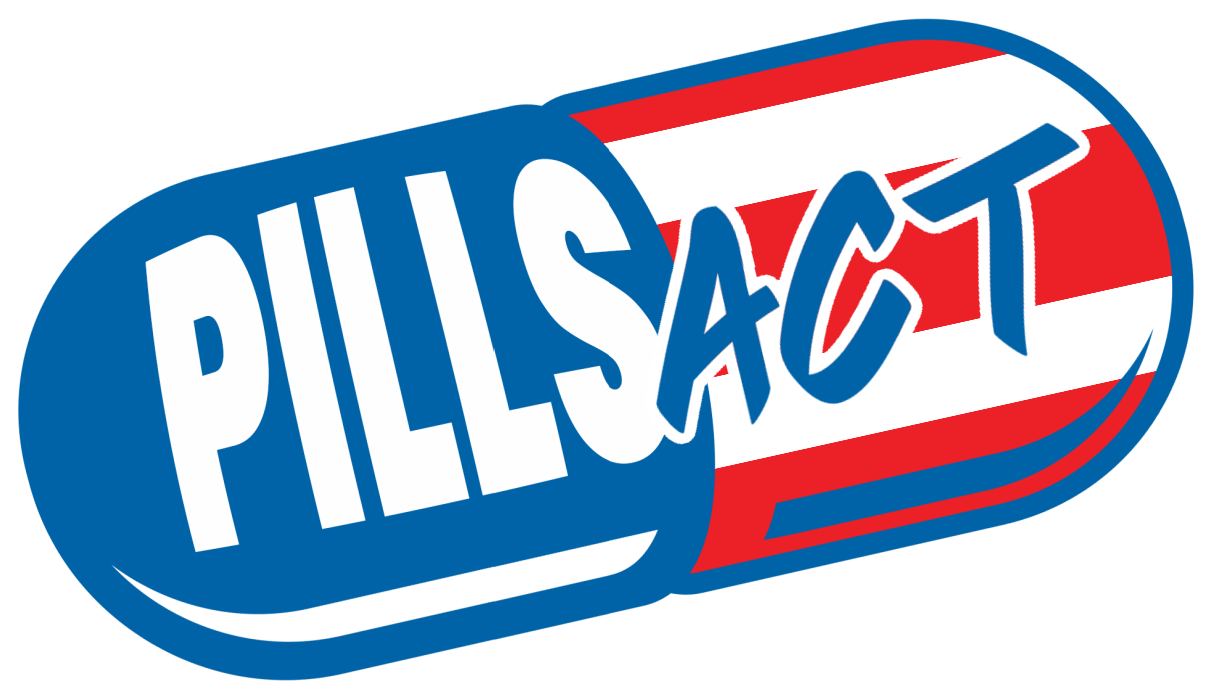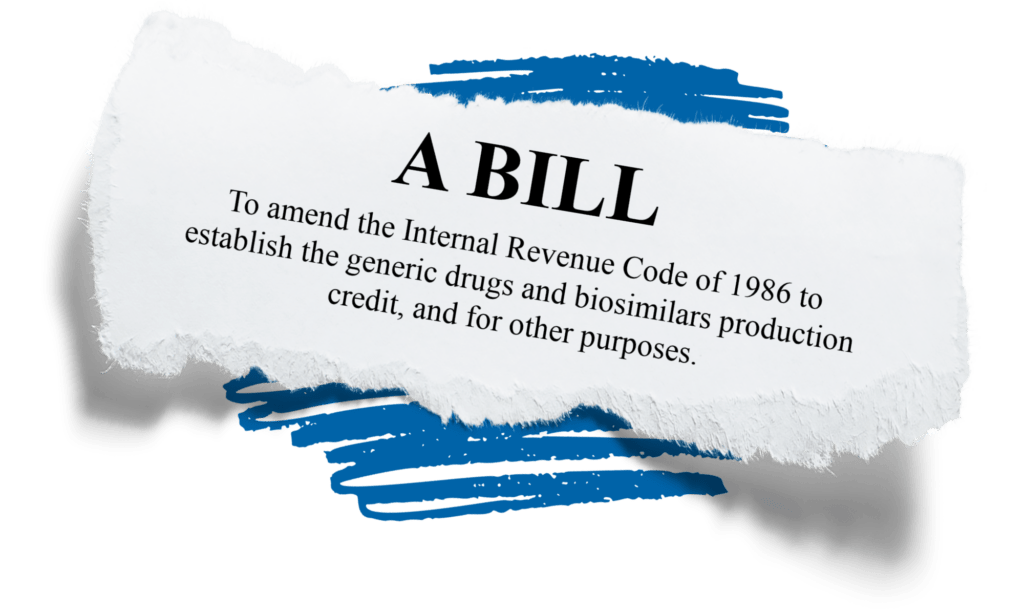
YOUR MEDICINE, MADE IN AMERICA.
PRODUCING INCENTIVES FOR LONG-TERM PRODUCTION OF LIFESAVING SUPPLY OF MEDICINE

Introducing legislation to reshore the U.S. generic Drug Supply Chain Through Production-Based and Investment Tax Credits
OBJECTIVE: To incentivize the strategic reshoring of US production of generic medicines, to cover all materials, testing, and packaging involved at every step of the manufacturing process. This includes upstream inputs such as active pharmaceutical ingredients (API), and downstream materials and services such as packaging and quality testing.
KEY COMPONENTS
The PILLS Act
- PRODUCTION-BASED TAX CREDIT
- DOMESTIC CONTENT BONUS
- INVESTMENT TAX CREDIT
- 35% for final manufacturers of APIs and finished drug products and 30% for all other components
- Calculated as a percentage of the value added by the manufacturer (gross receipts minus the cost of any “eligible components” purchased from third parties)
- Ensures that any value added at prior or subsequent steps in the manufacturing process is excluded (no “double-dipping”)

- An additional, bonus credit is awarded for the proportion of domestic content in the drug’s constituent materials, up to 20% additional for 100% domestic content
- Incentivizes firms to maximize U.S. content at each stage in a drug’s production to claim as much eligible credit as possible

- Optional election equal to 25% of the qualified investment to offset costs of creating new production capacity (in lieu of a PBTC election)
- Most useful for antibiotics producers with immense capital costs to stand up fermentation plants

What does the PILLS Act do?
Establishes the title of the Act as the “Producing Incentives for Long-term production of Lifesaving Supply of medicines (PILLS) Act”.
Adds new section 45AA to the Internal Revenue Code to establish the “generic drugs and biosimilars production credit.”
The PTC is patterned after Section 45X of the Internal Revenue Code (26 U.S.C. 45X) – the “advanced manufacturing production credit,” enacted as part of the Inflation Reduction Act of 2022.[i] Section 45X provides business tax credits under Section 38 of the Code for production of components used in solar, wind, and battery energy equipment and for production of certain listed critical minerals.
[i] Pub. L. 117-169 (Tax-Related Portions of the Inflation Reduction Act of 2022), title I, §13502(a), Aug. 16, 2022, 136 Stat. 1971.
Executive Order 13994 and the resulting FDA list of essential medicines are limited to medicines and supplies necessary in public health emergencies and for national defense. The FDA has noted that the list does not include other medicines that “are important and medically necessary for many patients.” [i] The draft bill therefore is not limited to items described in the Executive Order and FDA list; rather, it applies to all generic drugs and all generic biologics (“biosimilars”). [Sec. (c)(1), (c)(2).]
[i] The FDA’s published criteria for inclusion in the list states as follows:
General criteria for the essential medicines portion of the list
Approved medicines that are necessary to address immediately life-threatening medical conditions that are encountered in US acute care medical facilities, and that are used to stabilize patients with those medical conditions so that patients can be discharged for continued outpatient care.
Medicines used for longer-term chronic management, including those needed to cure a condition through weeks or months of outpatient treatment, are not included. While these medicines are important and medically necessary for many patients, the list is focused on addressing more immediate medical needs that are likely to occur in a public health emergency. [Emphasis supplied.]
Criteria For Identifying Human Drug and Biologic Essential Medicines, Medical Countermeasures, and Critical Inputs for the List Described in Section 3(c) of the Executive Order (EO) 13944. Available for download at:
The bill is intended to cover all materials, testing, and packaging involved at every step of the generics manufacturing process. [Sec. (c)(2).] [i] The finished product, and all of these products and processes, are referred to as “eligible components,” eligible for the production credit. [Sec. (c)(2).]
[i] Section 45X includes a credit for production of critical minerals; presumably these are essential to the production of the clean energy products “eligible components” included in the section. If there were identifiable starting materials or other substances critical to production of generics, a provision like that of Section 45X offering credits for their production could be added to the bill. However, the bill as written is intended to include these within its scope.
Section 45X mostly calculates the credit in terms of dollar amounts. (It provides for a credit of 10% of the sales price of solar wind towers, and 10% of the cost of producing electrode active materials and critical minerals.)
The draft bill adopts a value-added approach, calculating the credit as a percentage of the value added by the taxpayer. Like Section 45X, the credit is limited to production that occurs in the United States.[i]
The taxpayer’s value added with respect to an eligible component is equal to the taxpayer’s gross receipts minus the cost of inputs purchased from third parties. [Sec. (b)(3).] This approach excludes any value added at prior or subsequent steps in the manufacturing process.
The amount of the credit is equal to the value added to such component by the taxpayer, multiplied by the “base credit percentage”. [Sec. (b)(1).]
The base credit percentage is 30%, increased to 35% for final manufacturers of APIs and finished drug products. [Sec. (b)(2).] (The initial credit amount is then eligible for a domestic content bonus, as discussed below.)
[i] Section 45X also includes production in U.S. territories; the draft bill also does not, but rather is limited to production in the 50 states and the District of Columbia.
The base credit percentage is increased by the domestic content percentage multiplied by a factor of 0.20. (For example, a domestic content percentage of 100 percent would result in an increase of 20 percentage points). [Sec. (b)(3)(A).]
The domestic content percentage is the percentage of the total cost of the bill of materials of the eligible component that is attributable to materials and components that were produced in the United States. [Sec. (b)(3)(B).]
The goals of this draft bill are to (i) incentivize the entire supply chain to produce domestically and (ii) keep the mechanism simple.
We incentivize domestic production up and down the supply chain by giving credit for, and only for, the value that is added by a particular company, thus achieving comprehensive coverage while avoiding double counting. Additionally, each company is incentivized to source its own immediate inputs domestically, via the domestic content bonus credit.
As to simplicity, we can keep the formula for determining value added simple (sales price minus cost paid for inputs, the bill of materials), because we can regulate the amount of the credit earned via the percentage of the credit, as a percentage of the sales price.
And we don’t need to go more than one input deep in determining the bonus credit, because each producer in the supply chain, being eligible for a credit for its own value added, is incentivized to have its own immediate inputs domestically sourced, so as to qualify for its own bonus credit.
Any article is ineligible for the credit if any production of the article, or of any of the materials and services used in the production of the article, occurred at a facility which is the subject of a warning letter (i) which was issued by the Food and Drug Administration on or after September 1, 2009, and (ii) with respect to which the Food and Drug Administration has not issued a close-out letter. [Sec. (c)(2(C).]
Section 45X provides for a phase-out of the credits for energy components, but not for critical minerals. The credit for energy components is phased out in 25% increments over the four-year period 2030 through 2032. A like phase-out of the credits is included in the bill. [Sec. (b)(5).] However, noting that the credit for critical minerals is not phased out, this provision could be deleted from the bill as introduced, at the sponsor’s discretion.
Section 45X excludes an “eligible component” that is produced at a facility to which the “qualifying advanced energy project credit” of section 48C has been applied. Similarly, the draft bill excludes an “eligible component” that is produced at a facility to which the investment credit established under Section 3 of the bill has been applied. [Sec. (c)(2)(D).]
Adds new section 48F to the Internal Revenue Code to establish the ““generic drugs and biosimilars investment credit.”
For some sectors in the generic drugs and biosimilars industry, for example, antibiotics, it may be helpful to provide an option to elect an “investment tax credit” to offset costs of creating new production capacity, in lieu of a “production tax credit” for ongoing production of products and components. Such a provision is included in Section 3 of the bill. (The production tax credit will not be available in cases where the investment tax credit has been claimed.)
Section 3 is patterned closely after the “advanced manufacturing” investment tax credit created in the CHIPS Act of 2022, P.L. 117-67, section 107, codified at 26 U.S.C. § 48D.
The CHIPS investment credit is available for investment in “a facility for which the primary purpose is the manufacturing of semiconductors or semiconductor manufacturing equipment.” Section 3 provides an investment credit for investment in “a facility for which the primary purpose is the production of eligible components,” with eligible components defined as:
“(i) an approved generic drug,
“(ii) a licensed biosimilar; and
“(iii) any drug substances, intermediates, raw materials, reagents, components, in-process materials, inactive ingredients, container closure systems, packaging, quality testing, and other materials and services intended for use in the production of an approved generic drug or a licensed biosimilar.
Dates in section 3 are one year later than the dates provided in the CHIPS Act.

WHAT PEOPLE ARE SAYING
The PILLS Act is an incredibly important bill that would create massive incentives to strategically reshore U.S. domestic production of generic medicines. Our country is facing a national health care crisis due to ongoing, and worsening, shortages of essential lifesaving generic drugs, which account for roughly 90% of all prescriptions dispensed in the U.S. Currently, the U.S. is dangerously dependent on foreign manufacturers—particularly in China and India—for essential, lifesaving generic medicines. Since 2002, imports from India have increased 35x, while the floodgates have opened to allow imports from China to rise to an astounding 165x their 2002 levels. This should sound alarm bells through Washington and highlight the need to pass the PILLS Act in order to address the shortage crisis and rebuild America’s domestic production of generics, antibiotics, and other key medicines.
ZACH MOTTL
CHAIRMAN, COALITION FOR A PROSPEROUS AMERICA
In recent years, drug manufacturing has shifted away from the United States, threatening American jobs and the security of our vital medicine supply chains. To bolster domestic generic medicine production and guard against future supply chain disruptions, I introduced the PILLS Act to incentivize businesses to produce these important pharmaceutical products in the United States. This legislation is a crucial step to not only re-shore drug production, but also to strengthen our domestic supply chains and create American manufacturing jobs.
REP. CLAUDIA TENNEY
(R-NY)




